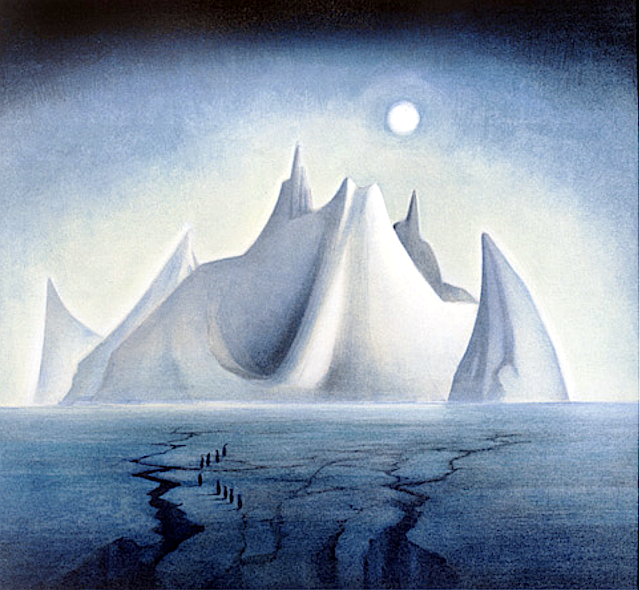
VEJBJØRN SAND (bn. 1966)
Trollslottet mountain (2,737 m- 8,930 ft)
Antarctica
In Trollslottet, 1997, Antarctica
About this Painting
After an expedition to Antarctica, Queen Maud Land (Independent Norwegian territory in Antarctica) , Vebjørn completed his first public work, The Troll Castle (Trollslottet) which was inspired by the voyage. In collaboration with the team who arranged the opening of the Winter Olympics at Lillehammer in 1994, Vebjørn constructed a “Mini Antarctica” formed by 10 towers surrounding a circle, all reminiscent of Arnesteinen, a mountain shooting out of the ice in the shape of a cathedral. Inside the castle Vebjørn included paintings (as the one above) conceived and executed in Antarctica, stored inside glass boxes to resemble ice. The castle was designed so that visitors could walk inside the space and experience a frigid atmosphere similar to the one Vebjørn did when he painted them. During the first 3 months of its opening in the winter of 1997/98, 180,000 people visited the Troll Castle.
The mountain
Trollslottet
Mountain (2,737m - 8,930ft) situated at 71°56′S 7°14′E, is a high
ridgelike mountain with several prominent peaks forming the northwest
limit of the Filchner Mountains in Queen Maud Land (Independant Norwegian territory
in Antarctica). Plotted from surveys and air photos by Norwegian
Antarctic Expedition (1956–60) and named Trollslottet (the troll
castle). The Filchner Mountains are a group of mountains 11 km (7 mi)
southwest of the Drygalski Mountains, at the western end of the Orvin
Mountains of Queen Maud Land, Antarctica. They were discovered by the
Third German Antarctic Expedition (1938–1939), led by Capt. Alfred
Ritscher, and named for Wilhelm Filchner, leader of the German
expedition to the Weddell Sea area in 1911–12. They were remapped from
air photos taken by the Sixth Norwegian Antarctic Expedition, 1958–59
The Painter
Vebjørn
Sand (born March 11, 1966) is a Norwegian painter and artist. He is
known for his paintings as well as his public arts projects, such as the
Da Vinci Project, and the Kepler Star monument (Norwegian Peace Star)
at Oslo Airport, Gardermoen.
Building off the original Da Vinci
bridge in Norway, Vebjørn used Leonardo's philosophy of encompassing all
fields of research to use the project to discuss global warming. First
he used ice to reinterpret and construct a new bridge during his
expedition to Queen Maud Land in Antarctica. After that, in December of
2007, Vebjørn erected a temporary ice bridge to dramatize the melting
glaciers of Antarctica due to climate change outside of the United
Nations Plaza in New York. During the unveiling at the U.N.
Headquarters, Vebjørn said of the bridge in Antarctica,
“Our
future lays underneath that ice glacier. So to erect it on that glacier,
and that part of Antarctica, (it) must never melt. The one outside the
United Nations is intended to melt to show that Antarctica is melting.”
The
bridge was unveiled earlier that year two days after nearly 200 nations
agreed at the U.N.-led talks in Bali to launch negotiations on a new
pact to fight global warming.
In 2009, Vebjørn built another ice
bridge in Ilulissat, Greenland (where most icebergs are borne into the
sea). Later that year in Copenhagen, as part of the United Nations
Climate Change Conference, also known as COP15, Vebjørn constructed yet
another ice bridge in front of the Danish Parliament to raise global
awareness of climate change.
2021 - Wandering Vertexes...
by Francis Rousseau